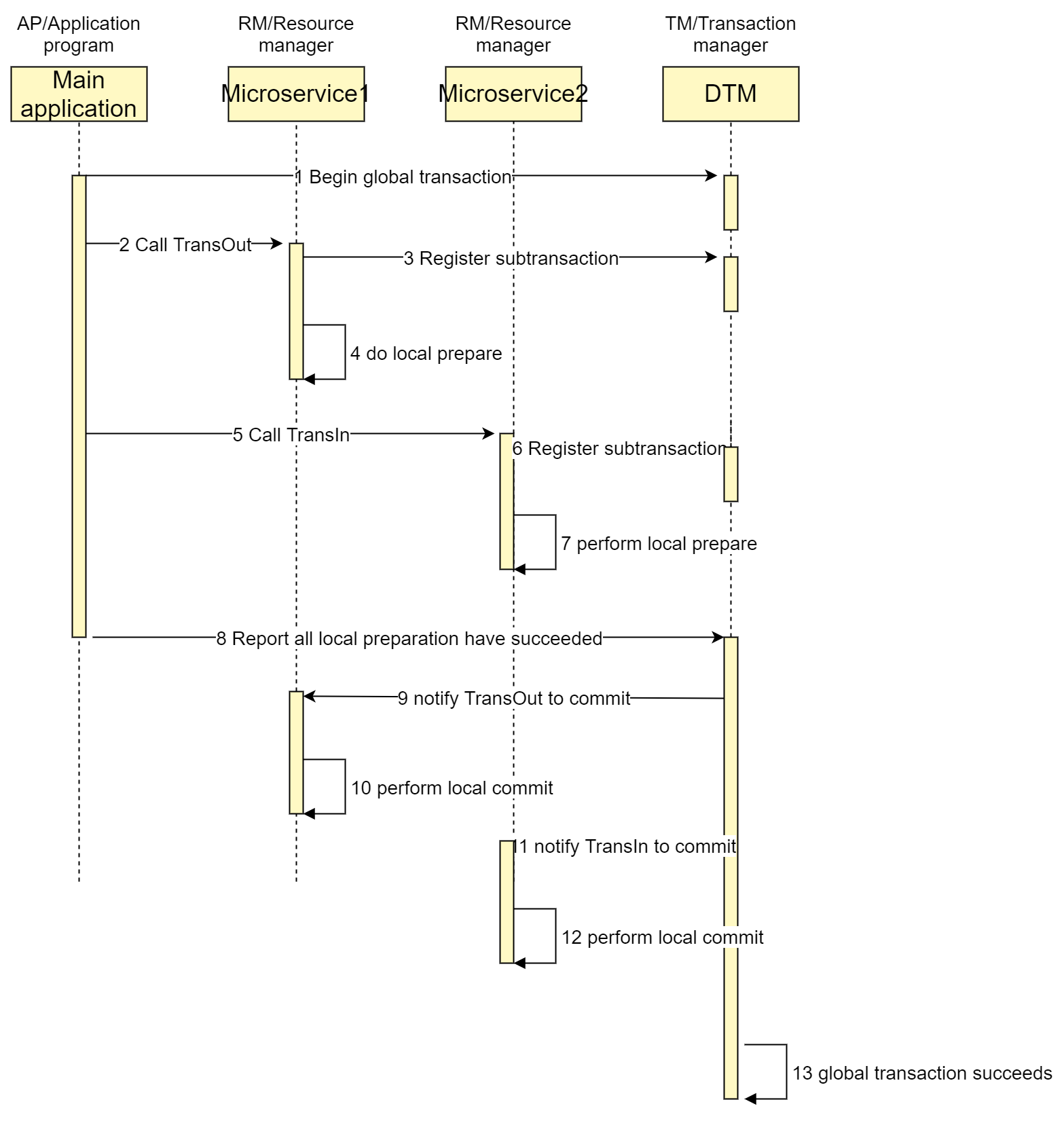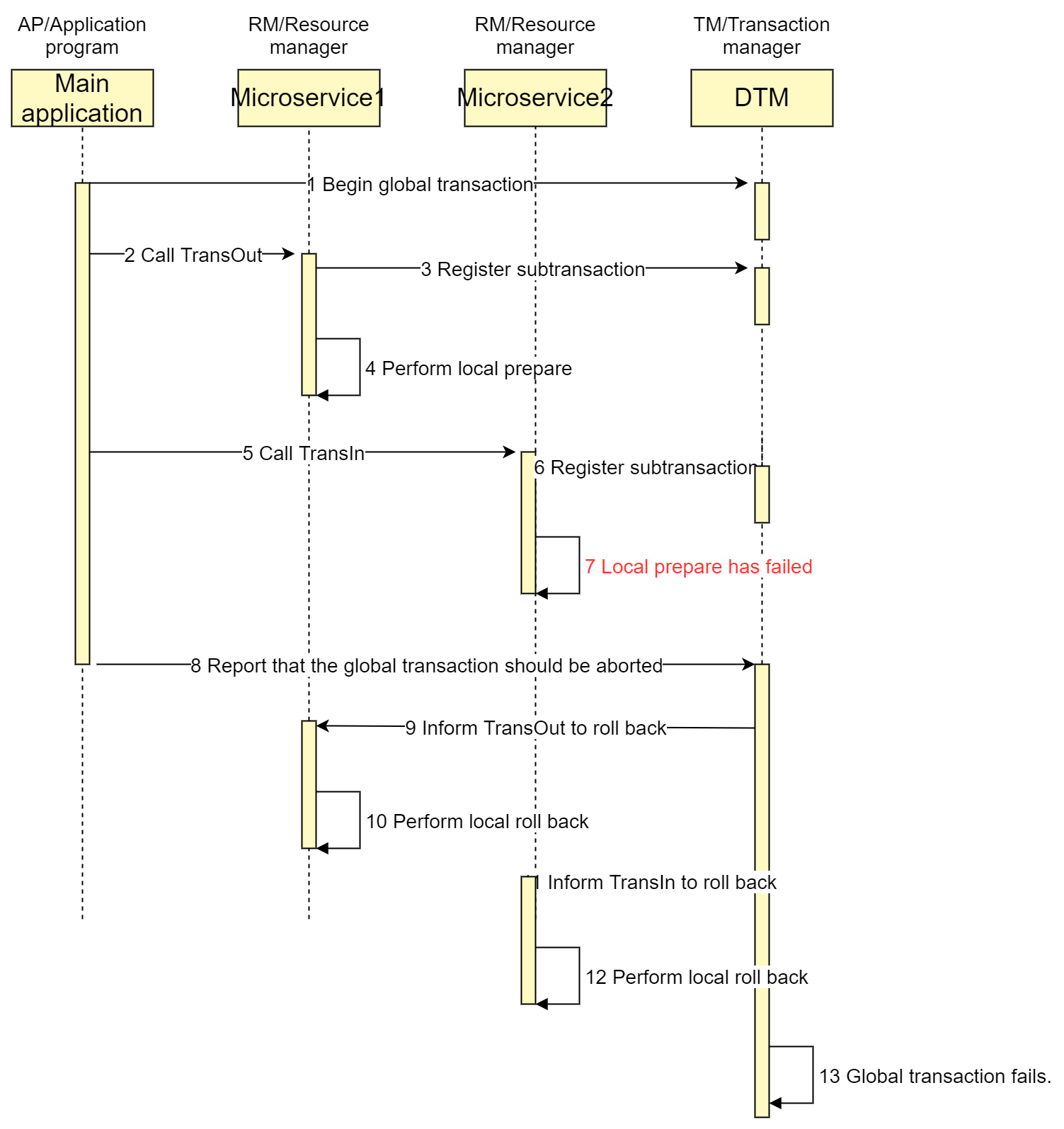XA
What is XA
XA is a specification for distributed transactions proposed by the X/Open organization. The X/Open Distributed Transaction Processing (DTP) model envisages three software components:
- An application program (AP) defines transaction boundaries and specifies actions that constitute a transaction.
- Resource managers (RMs, such as databases or file access systems) provide access to shared resources.
- A separate component called a transaction manager (TM) assigns identifiers to transactions, monitors their progress, and takes responsibility for transaction completion and for failure recovery.
The following figure illustrates the interfaces defined by the X/Open DTP model.

XA is divided into two phases.
Phase 1 (prepare): All participating RMs prepare to execute their transactions and lock the required resources. When each participant is ready, it report to TM.
Phase 2 (commit/rollback): When the transaction manager (TM) receives that all participants (RM) are ready, it sends commit commands to all participants. Otherwise, it sends rollback commands to all participants.
At present, almost all popular databases support XA transactions, including Mysql, Oracle, SqlServer, and Postgres
XA in Mysql
Let's see how database Mysql supports XA.
XA start '4fPqCNTYeSG' -- start a xa transaction
UPDATE `user_account` SET `balance`=balance + 30,`update_time`='2021-06-09 11:50:42.438' WHERE user_id = 1
XA end '4fPqCNTYeSG'
-- if connection closed before `prepare`, then the transaction is rolled back automatically
XA prepare '4fPqCNTYeSG'
-- When all participants have all prepared, call commit in phase 2
xa commit '4fPqCNTYeSG'
-- When any participants have failed to prepare, call rollback in phase 2
-- xa rollback '4fPqCNTYeSG'
Business Scenario
An inter-bank transfer is a typical distributed transaction scenario, where A needs to transfer money across a bank to B. Both the withdraw and the deposit may succeed or fail, and it is required that the sum of balance of A and B should not change after the transfer finished, regardless of any errors that occur.
Implement a Distributed XA Transaction
Distributed XA transactions can solve the above business problem. A successful global transaction is illustrated by the following figure:

The code to implement it in Go is quite simple:
gid := dtmcli.MustGenGid(dtmutil.DefaultHTTPServer)
err := dtmcli.XaGlobalTransaction(dtmutil.DefaultHTTPServer, gid, func(xa *dtmcli.Xa) (*resty.Response, error) {
resp, err := xa.CallBranch(&busi.TransReq{Amount: 30}, busi.Busi+"/TransOutXa")
if err != nil {
return resp, err
}
return xa.CallBranch(&busi.TransReq{Amount: 30}, busi.Busi+"/TransInXa")
})
app.POST(BusiAPI+"/TransInXa", dtmutil.WrapHandler2(func(c *gin.Context) interface{} {
return dtmcli.XaLocalTransaction(c.Request.URL.Query(), BusiConf, func(db *sql.DB, xa *dtmcli.Xa) error {
return AdjustBalance(db, TransInUID, reqFrom(c).Amount, reqFrom(c).TransInResult)
})
}))
app.POST(BusiAPI+"/TransOutXa", dtmutil.WrapHandler2(func(c *gin.Context) interface{} {
return dtmcli.XaLocalTransaction(c.Request.URL.Query(), BusiConf, func(db *sql.DB, xa *dtmcli.Xa) error {
return AdjustBalance(db, TransOutUID, reqFrom(c).Amount, reqFrom(c).TransOutResult)
})
}))
The above code first registers a global XA transaction, and then calls two sub-transactions TransOut, TransIn. After all the sub-transactions are executed successfully, the global XA transaction is committed to DTM. DTM receives the commitment of the XA global transaction, then calls the XA commit of all the sub-transactions, and finally change the status of global transaction to succeeded.
Code samples in other languages can be found here: SDKs
Run It
You can run the above example by running the following commands.
Run DTM
git clone https://github.com/dtm-labs/dtm && cd dtm
go run main.go
Run Example
git clone https://github.com/dtm-labs/dtm-examples && cd dtm-examples
go run main.go http_xa
Rollback upon Failure
If any prepare operation fails, DTM will call XA rollback of each sub-transaction to roll back, and finally change the status of the global transaction to failed.
Let's pass TransInResult="FAILURE" in the request payload of XaFireRequest to trigger a failure.
req := &busi.TransReq{Amount: 30, TransInResult: "FAILURE"}
The timing diagram for failure is as follows:

Notices
- The command of second phase, is also sent to the API
BusiAPI+"/TransOutXa", and within this service,dtmcli.XaLocalTransactionwill automatically callXA commit|XA rollback. So the body of the request is nil, and parsing body operations, such as the previousreqFrom, need to be placed insideXaLocalTransaction, otherwise the body parsing will result in errors.
TM Failure
The complexity of two-phase commit comes from all the failure scenarios that can arise. The most annoying failure happens after a participant has acknowledged prepared and before it receives the decision, such as a failure of the coordinator.
Our solution to this failure is quite simple and robust. Since most of cloud vendors provide highly-available databases, we can store the progress of sub-transactions in these databases, run multiple instance of TMs. Each instance will poll the paused transactions and continue to process them.
The cloud vendor takes care of the database failure, and may use Paxos/Raft to robustly elect a healthy instance.
Advantages and Disadvantages
Compared to other patterns like SAGA and TCC, the advantages of XA global transactions are:
- Simple and easy to understand
- Automatic rollback of business, no need to write compensation manually
The disadvantages of XA are:
- Need the XA transaction from underlying database
- Data is locked from data modification until the commitment, much longer than other patterns. It not suitable for highly concurrent business.
Conclusion
In this article, I've introduce the basic principle of XA transaction, and presents a practical example of it. Readers can easily follow the example to handle their own businesses.